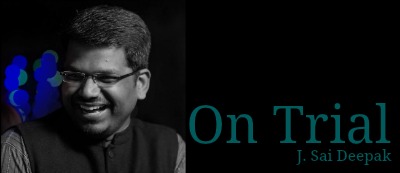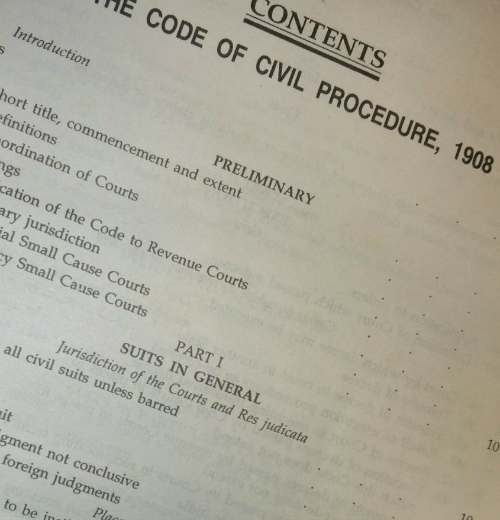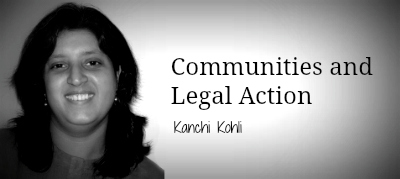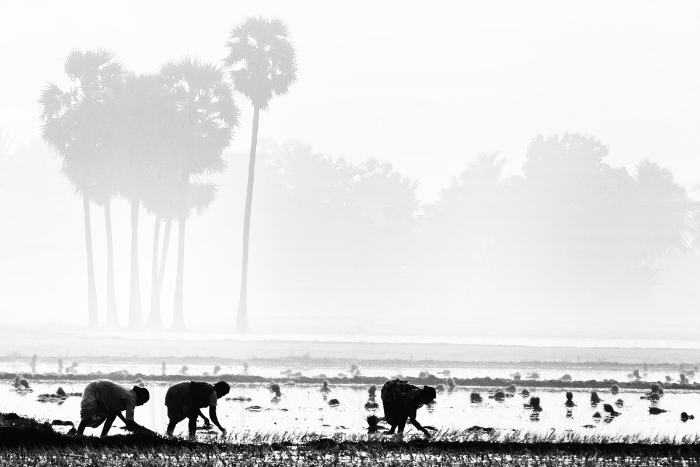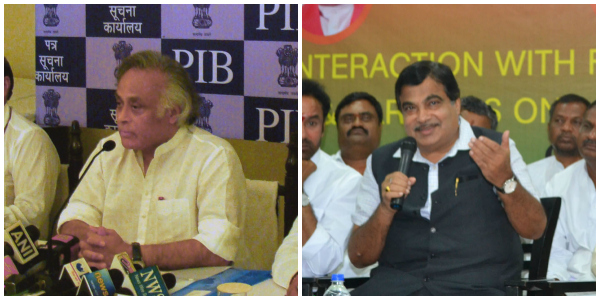
(Apar Gupta is a Delhi-based advocate and Sanjay Hegde is a Senior Advocate of the Supreme Court of India.)
From: Apar Gupta
Dear sir,
I am writing to you looking for answers and for hope.
The practice of law is an art but it has never required martial combat. One week ago, lawyers in the Patiala House courts challenged the genteel nature of legal practice by practising criminal assaults in the court premises. This has been done successively over two days within the premises of the court complex and besides the India Gate circle. I repeat this because the location is important. It shows how less than a mile away from the Supreme Court, the rule of law was subverted to a rule by force.
On February 16, 2016, some lawyers acting in groups beat up Kanhaiya Kumar a student, his family, friends, college professors, and journalists. On February 17, 2016, when reports of similar assaults emerged, six senior advocates were rushed to that location under orders of the Supreme Court. Reports indicate that even though they went to the Patiala House Courts with police protection, stones and flowerpots were flung at them. They were called dreadful abuses accusing them of incest and questioning their allegiance to the country. On returning to the Supreme Court, they called the situation, “unprecedented”.
This raises a frightening possibility – a situation in which the writ of the Supreme Court stops at the steps of the Patiala House Court. Where even under its supervision, lawyers not only defy the law but also exhibit such defiance on national television. The practice of law requires courage but it has never required the audacity to undermine the Supreme Court.
It would be myopic to reduce the blame to a few violent lawyers. The Delhi Police bore witness to this affront to the rule of law on both days. It did not prevent the violence. It did not police. The Delhi Police Commissioner in subsequent interviews has said that preventing the violence could have caused “collateral damage”, an apt term owing its seed in popular culture to the Gulf War and drone strikes. It captures the deprivation of basic human rights of an accused and working journalists perfectly. It displays how norms of human decency, which find their way in law, give way to the rule of force and might. Brazen statements by the Commissioner and the police inaction on the second day despite judicial oversight raise further questions on the Court’s authority.

Alexander Hamilton in the federalist papers termed the judiciary, “the least dangerous branch”. He reasoned that the Court relies on the existing branches to ensure compliance and enforce its orders, compliance that comes through the obedience of the political executive and the police acting under it. This is necessary in a society that is governed by a rule of law. When lawyers publicly exhibit defiance to it and the police condone it — how is the Court to act? Does it moderate or limit the wide powers it can exercise for contempt? Does it err on the side of caution? Is it not reasonable to fear that any hesitance to act firmly may encourage further acts of defiance, which seek immunity by false claims of nationalism?
There is some reason for my pessimism. On December 2, 2014 the Supreme Court issued a peculiar circular. It said, “On 24.11.2014 an Advocate, wearing black gown, band and a saffron color long gown entered into the Hon’ble Chief Justice’s Court which was viewed seriously. It has been directed that, in future, Advocates only in proper uniform be allowed entry into the Court Rooms.” On February 18, 2016 in the midst of a hearing in the Supreme Court concerning the Patiala House Court violence a lawyer disrupted proceedings shouting, “Vande Mataram”. Reports indicate that the Court pardoned him after he offered an apology. Reports further indicate that after being pardoned, he came out of the courtroom and stated, “I am not ashamed of what I did”. Viewed individually, the first incident is a minor transgression and the second is an attempt to overawe a court hearing. In both instances, the transgressions have received minor censure from the Court – a determination that rests solely within its discretion. I fear that further judicial compassion will only be mistaken for weakness.
But how far can the Court act under contempt? Can it trust the police to enforce the law? Events over the past few weeks bring me an acute sense of shame. This gives way to the much larger discomfort of threats to judicial independence — a situation when judicial orders reduce to mere words and the words in our statutes no longer have meaning; a society where the rule of law compromises its existence with the rule of force.
Sincerely,
Apar
From: Sanjay Hegde
Dear Apar,
To my mind, there is no doubt that the actions of the violent lawyers in Patiala house are criminal, destructive of the rule of law, and in contempt of the orders of the Supreme Court. They would in all probability be convicted if prosecuted properly or if proceeded against under the Contempt of Courts Act. I hope that they indeed are so proceeded against.
However, the prosecution and conviction of these individuals will be merely cosmetic if the underlying causes are not addressed. The chief cause to my mind, is that in a legal system that is stagnant and overwhelmed by the burden of arrears, only two kinds of lawyers get noticed, either the very famous or the very notorious. Notoriety is easier to achieve than fame, and a notorious lawyer, in due course gets cleansed into respectable authority, when he begins to invoke fearful compliance from opponents and courts.
A reputation as a troublemaker is not a bad reputation, when confronting judges who want to struggle through their never-ending list of cases to be heard on that day. A troublemaker lawyer, who can call for a strike and violence, who can paralyse the working of courts, will find himself being humored by judges who do not want trouble in the courtroom. Such a lawyer will soon find himself engaged by parties who want to overawe a court or derail proceedings in any matter. He will also be engaged by parties in a righteous cause, who will brief him only to prevent him from going over to the other side.
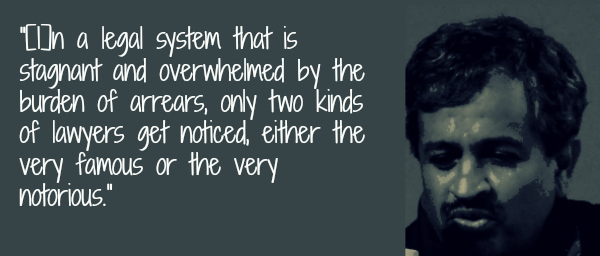
A troublemaker who can cow down judges is also more likely to be elected as a representative of the Bar than a lawyer whose chief virtue is well-researched articulation in court. These elected leaders of the Bar then get invited to social functions at welcomes and farewells involving judges. Elected offices at Bar associations then translate into upturns in practice. The ability to win a Bar election sometimes translates into a political candidacy as well. It seems to me that the system as it now exists, does not punish bad conduct but actually rewards it.
While Patiala House may have attracted attention because of its proximity to the Supreme Court, similar hooliganism has been seen in Chennai and Karnataka in recent years. In Chennai, the Chief Justice had to resort to Central forces, to ensure the conduct of peaceful proceedings in court. There are also times when Bar associations pass resolutions refusing legal assistance to some accused and then seek to enforce their diktat by violence. A decade ago in Jammu and Kashmir, trials of those accused in a sex scam had to be transferred outside the state because of such a resolution. Bluntly put, the average individual lawyer in India is less likely to be an Atticus Finch and more likely to follow or lead a mob.
The answer has necessarily to come from lawyers themselves. How do we make mob rule unprofitable and unsupported? How do we ensure that the leader of the mob today, is not the leader of the Bar tomorrow? How do we decriminalise our courts as a necessary precursor to the decriminalisation of politics itself? The all powerful Supreme Court in Delhi, if it fails to ensure condign punishment at Patiala House, may well become like that blind Mughal Emperor of whose nationwide jurisdiction, it came to be said, “Dilli te Palam, ast zameen Shah Alam”. From Delhi to Palam is the land of Shah Alam.
Regards,
Sanjay Hegde
From: Apar Gupta
Sir,
Two prominent points indicated by you in the previous thread push our conversation beyond the law of contempt. The first is case pendency and the second are usurpers at the helm of our Bar associations and councils. Both problems as you indicate are structural and require systematic engagement with time and patience. This can only be implemented specifically through the state bar councils and not episodic interventions by the Court. But what is the Bar Council today?
In my view, bar councils today act in the interest of lawyers but not in the interest of the legal profession. While they have the ability to structurally engage on issues of professional ethics and development, they rarely perform such a role, reduced over time to a body with allegiances to local groups aligned on lines of caste and religion and worse, political parties. While lawyers have always formed a large contingent of parliamentarians, there was always a conscious attempt to keep electoral politics at a distance from the practice of law. The independence of the judiciary is supported from the neutrality of the bar. This is increasingly under threat.
Recent events in which office bearers use the strength of their position to campaign for a political party, send SMSs soliciting support, and even hold seminars and rallies focused on lawyers give a cause for concern. Such incidents loosely link the social interest necessary in legal practice towards obedience and servitude of a particular political ideology. This is dangerous. For me, many lawyers (including me) who have been silent at such events in the past are to blame for the increasing brazenness that ultimately fructified in the Patiala House courts. I think any lawyer, whether working in a legal aid clinic or structuring a complex commercial agreement, can sense a growing influence of electoral politics in the practice of law. It is for the profession to decide whether they are willing to tolerate it further.
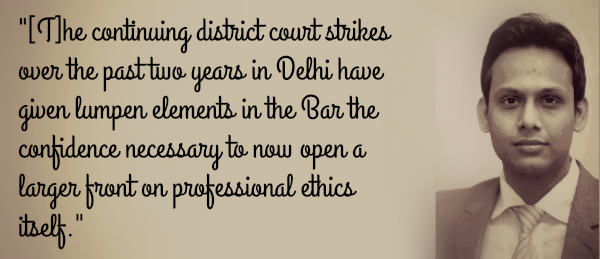
Another instance on which I see complete inaction by state bar councils are strikes organised by lawyers. Coordinated calls for strikes sometimes even arise from bar council members. Despite repeated and clear judgments by the Supreme Court that such strikes are illegal, this affront to the rule of law continues, practised by the very people who are licensed to professionally protect it. Even the courts maintain a studied silence when bar councils and associations announce strikes. Some even condone it by adjourning cases casually and treating it as an unsanctioned school holiday.
In my view, the continuing district court strikes over the past two years in Delhi have given lumpen elements in the Bar the confidence necessary to now open a larger front on professional ethics itself. Members of the legal community, especially seniors, need to actively support juniors whose bread and butter is immediately impacted due to the threats of violence and coercion which are used to prevent them from appearing in courts where such strikes are announced.
Strikes are just one form of a breach of professional ethics contained in the Advocates Act. The absence of action under it by bar councils is a worrying sign. It also points to a larger rot where complaints are dealt with in an opaque process and proximity to members of a bar council rather than the merits of a case may determine a finding of misconduct or the penalty which is imposed. To me the regulations require immediate surgical intervention. The hoary language that extolls the virtues of advocacy needs to be replaced by the commercial professionalism that a modern legal practice demands. The opaque and rusted process needs to be reformed after studying the reasons why the remedies suffer such weak enforcement.
One of my favourite quotes on this branch of law comes from the judgment of the Supreme Court in R.K. Anand v. Registrar, Delhi High Court where observing rampant professional misconduct, it notes that, “Such conduct reminds us of the fictional barrister Rumpole, `the Old Hack of Bailey’, who self deprecatingly described himself as an `old taxi plying for hire’. He at least was not bereft of professional values. When a young and enthusiastic journalist invited him to a drink of Dom Perignon, vastly superior and far more expensive than his usual `plonk’, `Chbteau Fleet Street’, he joined him with alacrity but when in the course of the drink the journalist offered him a large sum of money for giving him a story on the case; `why he was defending the most hated woman in England’, Rumpole ended the meeting simply saying “In the circumstance I think it is best if I pay for the Dom Perignon””. Unsurprisingly this judgment arises from a finding of contempt of court and not professional misconduct as found by a bar council. While this may merely be anecdotal, it is telling that contempt law is only imperfectly filling in a vacuum created by the bar councils.
Regards,
Apar
From: Sanjay Hegde
Dear Apar,
Thank you for recollecting the Rumpole example. I have a confession to make. Rumpole has been a great teacher to me for long, and I did introduce the series to Justice Alam who used it in the R.K. Anand judgment. It does seem to me that if Rumpole was Indianised to Vakil Rampal and a series set in a district court in India, many an appropriate lesson could be taught to the average Indian lawyer.
Rumpole would teach him that the first requirement of an advocate is courage, but that courage is not displayed by participation in or leadership of a mob. A lawyer’s true courage is when he gets up on his hind legs and cross-examines his witness to elicit the truth, regardless of suggestions from even a bully of a judge like Justice Bullingham, or from the icy condescension of a Justice Graves.
Rumpole would also teach a lawyer, that courage is in not meekly submitting to the advice of even your chamber mates and your friends, when such advice is detrimental to the client’s interests. A lawyer would learn also from the threat of disciplinary proceedings that Rumpole was subjected to by being reported to the benchers of his inn and to the professional services board. Lawyers could learn also from Rumpole’s fierce independence, which cost him a shot at being designated a Queen’s Counsel. In short, a Rumpolean philosophy of never pleading guilty, while forever perfecting the craft of persuasion, in a life interspersed with small cigars and Pomeroy’s ordinary wine, is a model with which many an individual lawyer would agree.
While the life of an Old Bailey hack epitomised by Rumpole is fast becoming an anachronism in Britain, it is still achievable for a Vakil Rampal, if only the profession as a whole sees itself as something more than a mere trade union of purveyors of the justice system. The Indian advocate often sees himself not as an officer of the court, but as a champion of his client within it. A lawyer usefully employed within the system, often does not have the time to look beyond his brief. But for large swathes of the profession, it is a mere refuge from the world outside, and a badge of a vocation no matter how tenuous. A lawyer suffering from disguised unemployment is an easy mark for the leader who is in want of a flock. Many a political party is populated with people who are nominally lawyers, but are rarely seen making a legal submission. Practice as a lawyer, is a useful adjunct to many a business like property dealings and the like. In short, the time available to a lawyer waiting to be briefed, is often a resource that is wasted or put to dishonorable pursuits.
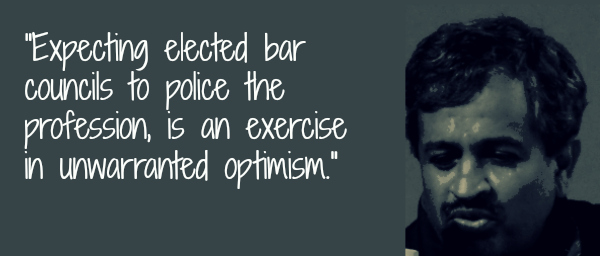
With disguised employment being the bane of an overcrowded profession, a number of people reliant on uncertain incomes tend to seek and find supplementary sources. These multitudes are often treated as individuals, only when their vote is solicited for elections to the bar associations of courts or to bar councils at the state and national levels.
Disciplining errant members of the Bar and checking their certifications and qualifications are all left to these elected bodies. Those who seek election to these bodies are loathe to move against potential and existing voters. Expecting elected bar councils to police the profession is an exercise in unwarranted optimism.
Courts too have contributed to the decline in standards by refusing to deny audience to errant members of the bar. R.K. Anand’s Case was unique in its invocation of contempt powers, but it was aided by press exposure, coupled with the vulnerability of Anand, who as a Senior Advocate, risked getting his designation revoked. It was in fact revoked and was a punishment that could not have been visited upon the average lawyer.
To my mind, the situation will not improve unless the lawyer genuinely is made to realise that he is an officer of the court and that the court has powers to curtail his continued tenure in that office. Unless a lawyer becomes a stakeholder in an organised system of justice delivery and ceases to act as a robber baron ruling through violence, the rule of law will not be truly established.
Regards,
Sanjay Hegde
From: Apar Gupta
Sir,
Your email gives a chance for introspection. It indicates that the answers many lawyers are searching for are present in their own practice. They are also timely, given the Supreme Court is examining the legality of the All India Bar Examination. Despite the derision directed against it, in principle few would quarrel with its aim to improve the quality of advocates in India — qualities both of the mind and the heart.
The Law Commission of India has been alive to these concerns for decades. In its 75th Report given in October 1978 titled “Disciplinary jurisdiction under the Advocates Act”, it underscores the need for self-regulation. Commending the system of advocates who form part of the disciplinary committees it recommends no change to the Advocates Act. It only takes a decade for it to revise and reverse this view. In 1988, in the 131st Report, the Law Commission noted two important things. First, a fall, or a “devaluation” of the lawyer in the public eye and second, a “hesitance to accept this implantable fact”. It suggests two key changes in the disciplinary system for adjudicating misconduct by advocates. It suggests that high courts should be given suo motu powers to review determinations made by the bar council of a state. There is also a suggestion for a social audit conducted by members of the public and civil society as “consumers of justice”. These are just two measures in a multitude which may be devised. There is an urgent need to devise substantive ethics regulations, periodic competency reviews, and enforce it by a system which is efficient and insulated from political pressure.

I agree with you that the best hope for the legal profession is in the daily practice of each lawyer but systems should create the proper incentives for its existence. Recent events give us a chance to not only individually reflect but also review the existing rules and systems for professional misconduct.
Thank you sir for engaging on this issue playing on the minds of many lawyers over the past two weeks. More personally, this exchange has given me the hope necessary to keep looking for answers.
Warmly,
Apar
From: Sanjay Hegde
Dear Apar,
While we agree that long term measures, based on greater professionalisation and lesser politicisation is the way to go, the immediate question is what immediate measures can be put in place towards that end.
Firstly, the Patiala House incidents must be used to totally disincentivise criminal behaviour of the type exemplified by Vikram Chauhan and his group. The Supreme Court must use the opportunity to send a tough message, by ensuring and monitoring prosecutions and disciplinary actions. The Court could also use the opportunity to devise newer measures to ensure that hooliganism is not rewarded and is in fact a disqualification to any elected office, including in bar association elections. Judgments of the Supreme Court in respect of its own bar elections are now setting the agenda for elections to other bar associations. A disqualifying clause, to be administered by presiding judges, upon those accused of violence or intimidation, would be very useful.
The next step, which can’t be delayed now, is requiring that advocates certification be renewed from time to time. Credentials are checked cursorily upon enrollment and thereafter rarely questioned. If the rolls are to be compulsorily revalidated every five years to weed out those who can show no proof of serious practice, then a huge burden of non-professionals can be weeded out.
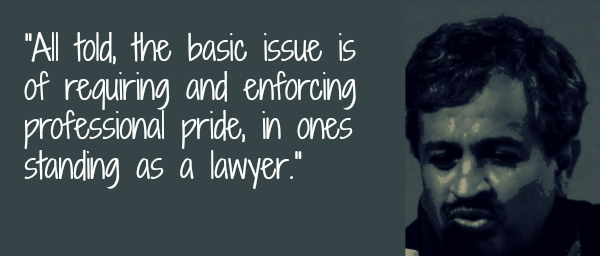
It may also be a good idea for technological solutions to be put in place, with a national registry of qualified lawyers, whose fingerprint scans can be used for recording court appearances. Data on frequency of appearances in court, as opposed to attendance in bar rooms might be revealing.
All told, the basic issue is of requiring and enforcing professional pride, in ones standing as a lawyer. As the saying goes, “he who will not stand for anything, will fall for everything”.
Regards,
Sanjay Hegde


